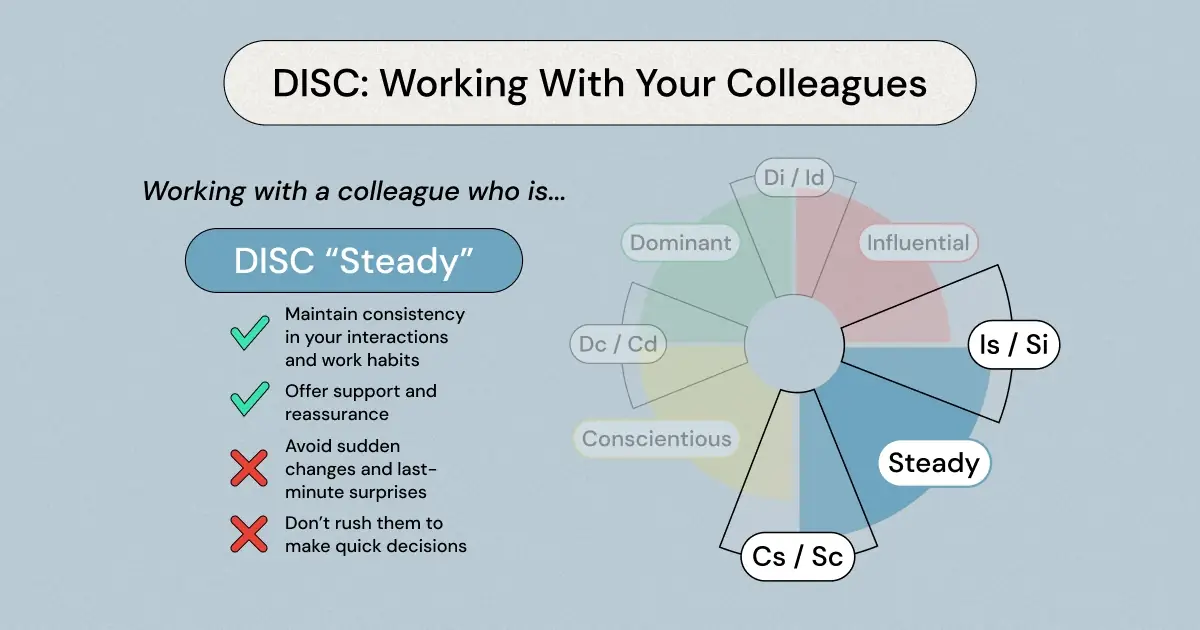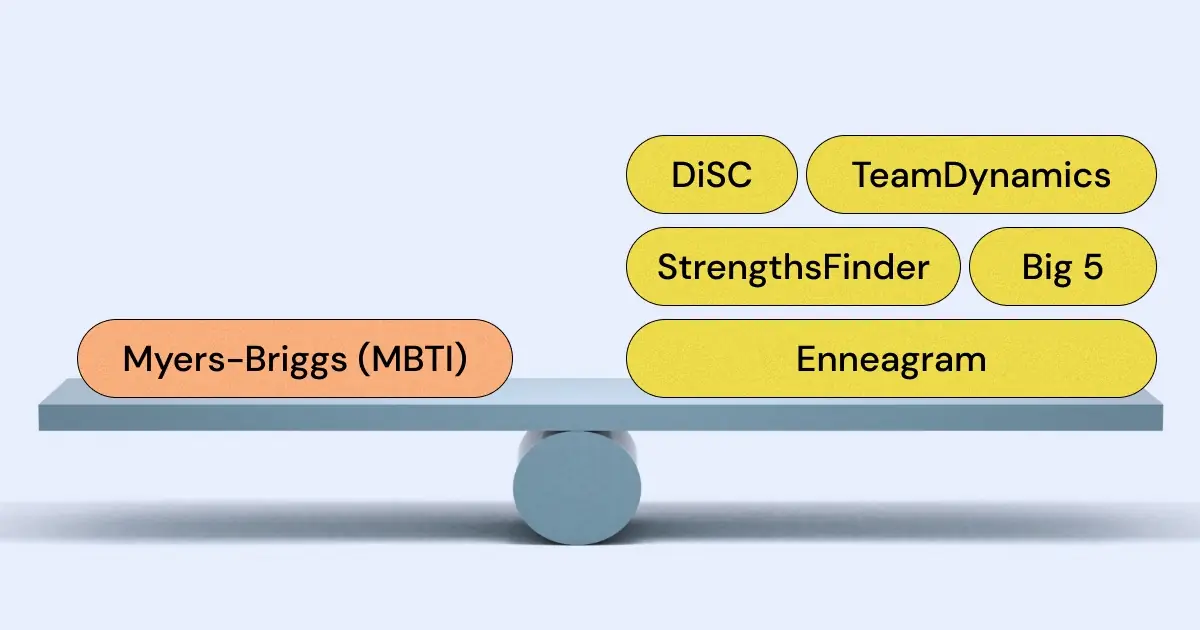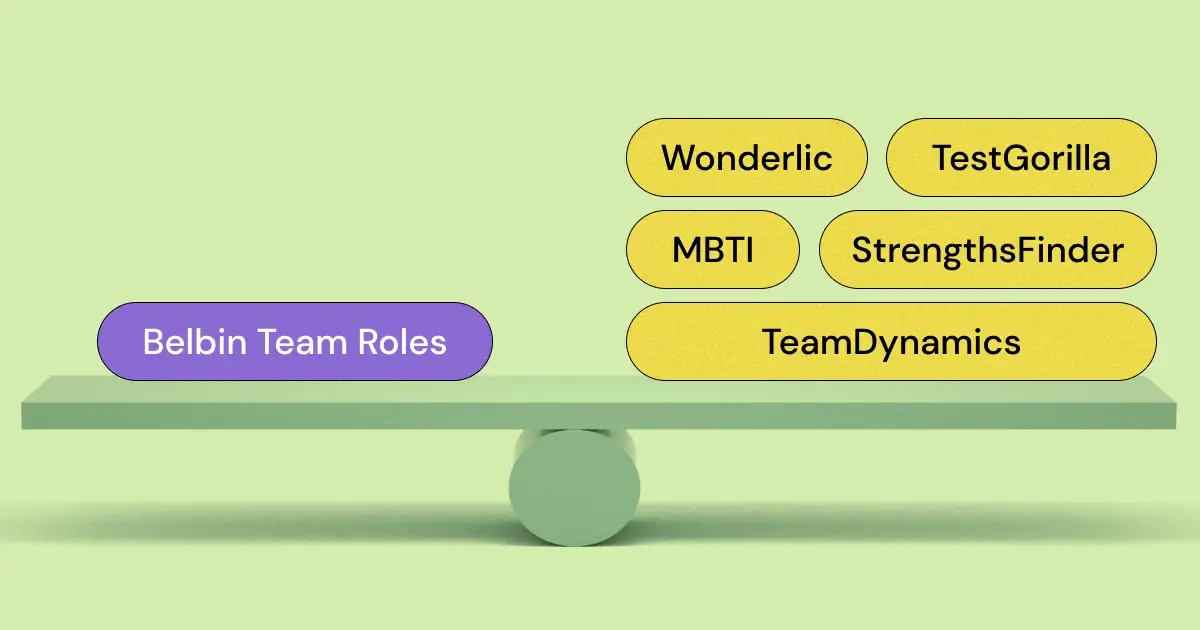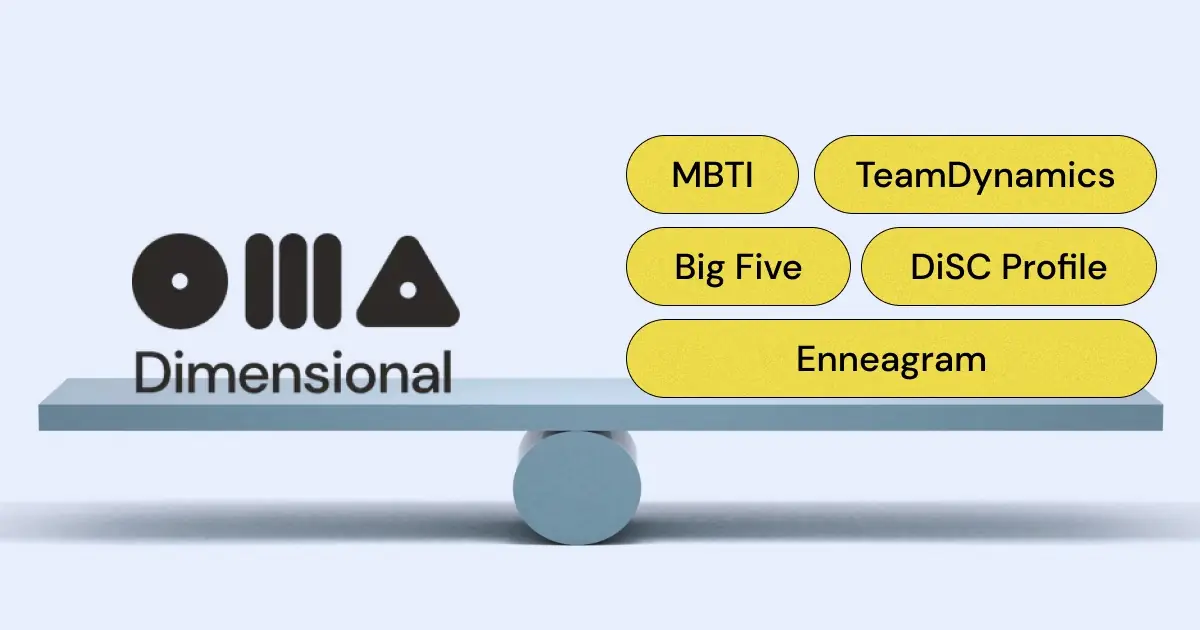Have you ever worked with someone who radiates calmness, seems unflappable under pressure, and is the go-to person for a steady hand in a storm? Chances are, you've encountered a colleague or boss with a "Steadiness" personality, as identified by the DISC assessment. This personality test tool is a game-changer in professional settings, helping us understand not just ourselves but also the people we work with daily.
Understanding the various DISC personality types is like having a secret weapon in the corporate world. It's not just about knowing who prefers coffee over tea. It's about deeper insights – how different personalities think, work, and interact. And when it comes to the "Steadiness" type, there's a lot to unpack. They're the unsung heroes of our teams, the ones who bring balance and reliability but often in a quiet, understated way.
In this post, we're diving into the world of the "Steadiness" personality. Whether you're part of a buzzing marketing team, a fast-paced tech startup, or a detail-oriented consulting group, understanding how to work effectively with "Steady" individuals can transform your work relationships. It's not just about getting along – it's about leveraging these insights to create a more cohesive, productive, and understanding team environment.
Want to learn how to get along with other DiSC profiles? Take a look at our guides to working with Dominant colleagues, Influential coworkers, and Conscientious collaborators at work.
So, let's break it down. We'll explore how to identify a "Steadiness" personality, and I'll share specific, actionable tips for working harmoniously with "Si" (Steadiness-Influential) and "Sc" (Steadiness-Conscientious) colleagues or managers. By the end of this post, you'll be equipped with the knowledge to turn every interaction with a "Steady" personality into an opportunity for teamwork success.
Stay tuned – because understanding the "Steadiness" personality could be your next big step in mastering the dynamics of your professional world.
Spotting the "Steadiness" Star in Your Team
Ever wondered why some people in your office seem to be the bedrock of calm and consistency, even when deadlines loom and tensions rise? They're likely your "Steadiness" personalities, a unique group we can identify using the DISC personality assessment. Recognizing these individuals isn't just a fun party trick; it's a crucial step in building stronger, more effective work relationships.
So, what are the tell-tale signs of a "Steadiness" personality? Here's the scoop:
- Calm in the Storm: They are the embodiment of calmness. When chaos reigns, they remain unflustered, bringing a sense of stability to the team.
- Reliable as Clockwork: Dependability is their middle name. Whether it's meeting deadlines or keeping promises, they're the ones you can count on, no matter what.
- Supportive Sidekicks: Ever noticed that colleague who's always ready to lend a hand or an ear? That's a classic "Steady" trait. They're fantastic at offering support and ensuring everyone feels included.
- Routine Lovers: Sudden changes? Not their cup of tea. "Steadiness" types thrive in predictable environments and consistent routines.
Understanding these traits is like unlocking a secret level in a video game. It lets you interact with your "Steady" colleagues in a way that resonates with them, enhancing collaboration and productivity.
Are you looking for a tool to help you understand how your team works and improve its performance? Consider trying TeamDynamics, the personality test for modern teams.
Here's the kicker: Recognizing a "Steadiness" personality isn't just about observing behaviors; it's about appreciating their role in your team's ecosystem. They're the ones who bring balance, reduce friction, and often act as the glue holding everything together.
In the following sections, we'll dive into how to work effectively with these invaluable team members. Whether they lean more towards the "Si" (Steadiness-Influential) or "Sc" (Steadiness-Conscientious) types, understanding and adapting to their style can lead to a more harmonious and productive workplace.
Stay tuned, because knowing how to collaborate with "Steadiness" personalities is a skill that will pay dividends in your professional journey!
Navigating the World of "Steady" Colleagues: A How-To Guide
Now that you can spot a "Steadiness" personality in your workplace, let's talk strategy. Working effectively with these individuals isn't just good for team harmony; it's a smart move for your career. Here's how you can excel in this endeavor.
- Patience is Key: Remember, "Steady" personalities aren't fans of rush jobs or last-minute changes. They value a thoughtful, measured approach. So, when you're working with them, patience isn't just a virtue; it's a necessity. Take the time to explain things clearly and give them space to process information at their own pace.
- Clear Communication is Your Best Friend: Ambiguity and "Steadiness" don't mix well. Be clear and direct in your communication. When you lay out expectations or project details, clarity can make a world of difference. This approach minimizes misunderstandings and builds trust – a currency of immense value in the workplace.
- Stability and Predictability for the Win: These individuals thrive in stable environments. If you're proposing a change or introducing a new idea, frame it in a way that emphasizes stability. Show them how the change fits into the bigger picture and maintains the team's equilibrium. This reassurance can turn their natural caution into a powerful asset.
- Show Genuine Support and Understanding: Recognize their need for a harmonious work environment. Offer your support, be it for a project or personal growth. This doesn't just show that you value their contribution; it demonstrates that you respect their approach to work.
Remember, "Steadiness" personalities aren't just about keeping things calm and predictable. They are often the unsung heroes who ensure that the team remains grounded and focused. By understanding and valuing their approach, you not only enhance your working relationship but also contribute to building a strong, resilient team.
In the next sections, we'll explore how to tailor your approach for "Si" (Steadiness-Influential) and "Sc" (Steadiness-Conscientious) types. Stay tuned, because these insights could be your secret sauce for workplace success!
{{inline-cta}}
The Art of Working with "Si" (Steadiness-Influential) Personalities
Welcome to the fascinating world of "Si" personalities – where steadiness meets sociability. These are your colleagues who not only bring a sense of calm but also have a flair for communication and influence. Working with them effectively can supercharge your team's creativity and collaboration. Here's how to do it:
- Encourage Open Discussions: "Si" personalities shine in interactive settings. They love to discuss ideas and share perspectives. Encourage this by creating opportunities for open dialogue. Whether it's a brainstorming session or a casual coffee catch-up, these conversations can spark innovative ideas and strengthen team bonds.
- Acknowledge Their Contributions: Recognition goes a long way with "Si" types. They thrive on positive feedback and public acknowledgment. A simple "great job on the presentation" or "your input was invaluable in the meeting" can boost their morale and motivation significantly.
- Balance Stability with Sociability: While they value stability, "Si" personalities also have an influential side that enjoys engaging with others. Strike a balance by providing them with a consistent framework within which they can express their sociability and influence. This approach allows them to feel secure while also leveraging their natural ability to connect with others.
- Involve Them in Decision-Making: Their blend of steadiness and influence makes "Si" types great at understanding different viewpoints and finding common ground. Involve them in decision-making processes, especially those that affect the team. Their input can be invaluable in achieving a consensus that respects both the task at hand and the people involved.
Working with "Si" personalities is like having a secret weapon in your team – they bring both the calming influence of steadiness and the dynamic energy of influence. By understanding and leveraging these traits, you can create a more dynamic, engaged, and productive team environment.
In the next section, we'll delve into the world of "Sc" (Steadiness-Conscientious) personalities. Stay tuned to discover how to work effectively with these detail-oriented, methodical team members!
Mastering Collaboration with "Sc" (Steadiness-Conscientious) Personalities
Diving into the world of "Sc" personalities, you'll find individuals who blend the best of steadiness and conscientiousness. They're the meticulous planners, the detail-oriented doers, the ones who uphold standards and stability. Here's how to collaborate effectively with them and turn their unique traits into team superpowers:
- Embrace Their Love for Details: "Sc" personalities are all about the details. They're the ones who read the fine print and remember the footnotes. When you work with them, provide detailed plans and information. Their attention to detail can be a tremendous asset, especially in projects that require precision and careful planning.
- Allow Time for Processing: Just like their "Steady" counterparts, "Sc" types appreciate having time to process changes or new information. Avoid springing surprises on them. Instead, introduce new ideas gradually, giving them ample time to adjust and provide their well-thought-out feedback.
- Value Their Thoroughness: The meticulous nature of "Sc" personalities means they're great at ensuring quality and consistency. Recognize and value their thorough approach. When they flag a potential issue or suggest an improvement, it's usually worth paying attention to.
- Provide Structured Environments: "Sc" types thrive in structured, orderly environments. When leading projects, create clear timelines, defined roles, and detailed processes. This structure not only makes them more comfortable but also allows them to perform at their best.
- Communicate Clearly and Precisely: Ambiguity is the nemesis of the "Sc" personality. Be clear and precise in your communications. Whether it's an email, a project brief, or a casual conversation, clarity and precision can prevent misunderstandings and ensure everyone is on the same page.
By understanding and embracing the unique strengths of "Sc" personalities, you can harness their meticulous nature for the benefit of your team. Their dedication to detail and love for structure can be invaluable in maintaining high standards and achieving project success.
Up next, we'll wrap up with strategies to navigate common challenges and build strong, lasting relationships with "Steadiness" personalities. Stay tuned for these final insights to round off your toolkit for workplace excellence!
Overcoming Challenges and Fostering Strong Bonds with "Steadiness" Personalities
While working with "Steadiness" personalities has its perks, like any relationship, it comes with its own set of challenges. Here's how to navigate these waters smoothly and build robust, enduring relationships with your "Steady" colleagues and managers.
- Embrace Change Gradually: One common challenge with "Steadiness" personalities is their natural resistance to rapid change. When introducing new ideas or processes, do it gradually. Present changes in a way that highlights benefits while providing reassurance and stability. This approach helps them transition more comfortably, reducing resistance and fostering acceptance.
- Build Trust Through Consistency: Trust is a critical element in any relationship, and with "Steady" personalities, it's built through consistency. Demonstrate reliability in your actions and commitments. Consistent behavior on your part can go a long way in building a strong foundation of trust and mutual respect.
- Communicate in Structured, Clear Ways: "Steadiness" personalities appreciate clear, structured communication. Avoid beating around the bush. Be direct yet respectful, providing information in an organized manner. This clarity not only aids understanding but also helps in building a straightforward and transparent working relationship.
- Respect Their Pace: Patience is vital. "Steady" types often take time to make decisions or adapt to new situations. Respect their pace and avoid rushing them. Providing the space they need to process information ensures they are comfortable and can contribute effectively.
- Offer Support and Reassurance: They value stability and support. Be a pillar they can lean on. Offering reassurance in times of uncertainty or change can strengthen your bond and enhance their sense of security within the team.
By understanding and addressing these challenges, you can create a work environment where "Steadiness" personalities not only feel valued but also thrive. Strong relationships with these individuals can lead to a harmonious, productive, and resilient team, capable of weathering any storm.
As we conclude, remember that the key to successful interactions with "Steadiness" personalities lies in understanding, patience, and clear communication. Implement these strategies, and watch your professional relationships transform, leading to a more cohesive and effective team.
Conclusion: Harnessing the Power of Understanding in the Workplace
As we wrap up our journey through the world of "Steadiness" personalities, let's take a moment to reflect on the profound impact of understanding and adapting to different personality types in professional environments. The DISC assessment, particularly the "Steadiness" dimension, offers us invaluable insights into how we can work more effectively with our colleagues and managers.
Remember, the key to thriving in a diverse workplace is not just about recognizing different personality types but also about how we adjust our approach to resonate with them. By implementing the strategies we've discussed for working with "Steadiness," "Si" (Steadiness-Influential), and "Sc" (Steadiness-Conscientious) personalities, you're not just improving individual relationships; you're fostering a more cohesive, productive, and understanding team environment.
The beauty of this knowledge is that it doesn't just stop at the office door. These insights into human behavior are universally applicable, enhancing interactions in all areas of life. The ability to understand and adapt to various personalities is a skill that will serve you well throughout your career and beyond.
So, as you move forward in your professional journey, carry these insights with you. Apply them, experiment with them, and watch as your workplace transforms into a more harmonious, efficient, and enjoyable space. The power of understanding and adapting to different personality types is immense, and you now have the tools to harness it. Here's to building stronger relationships and a more dynamic workplace, one interaction at a time!




.png)








































